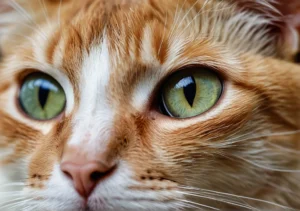Cats are known for their mysterious and often quirky behavior, including their adorable pink ears. But have you ever wondered why some cats have pink ears? The answer may surprise you.
Genetic Factors
When it comes to why some cats have pink ears while others don’t, genetic factors play a significant role. The color of a cat’s ears is determined by their genetic makeup. Certain genes can cause pigmentation in a cat’s ears, leading to them appearing pink. This is more common in white cats or those with light-colored fur. Cats with albino genes or dilution genes are more likely to have pink ears due to the way these genes affect melanin production in their skin and fur.
A unique insight into this topic is that certain breeds are more prone to having pink ears due to their genetic background. For example, Siamese cats are known for having pale pink ears, which is a distinct feature of the breed. This further highlights how genetics can influence the coloration of a cat’s ears.
Blood Flow
The color of a cat’s ears can also be influenced by their blood flow. When blood vessels in the ears dilate, they can become more visible through the skin, giving the ears a pink hue. This can occur due to various factors such as temperature changes, physical activity, or stress. Cats with thinner skin on their ears may also show more prominent pink coloration due to the proximity of their blood vessels to the surface.
In addition to blood flow, the presence of blood vessels near the skin surface in a cat’s ears can contribute to their pink appearance. The vascularity of the ears and how well they are able to regulate blood flow can impact the color of the ears, making them appear pink in certain circumstances.
Sun Exposure
Did you know that a cat’s ears can turn pink due to sun exposure? Just like humans, cats can get sunburned, and the sensitive skin on their ears is particularly vulnerable. If your feline friend enjoys lounging in the sun, especially outdoor cats, their ears may gradually turn pink as a result of prolonged exposure to UV rays. So, if you notice your cat’s ears starting to change color, consider providing them with some shade or even cat-safe sunscreen to protect their delicate ears from the sun’s harmful effects.
Health Considerations
While sun exposure is a common reason for pink ears in cats, it’s important to consider their overall health as well. In some cases, pink ears could be a sign of an underlying health issue. Conditions like ear infections, allergies, or even autoimmune diseases can cause inflammation and discoloration in a cat’s ears. If you notice persistent pinkness in your cat’s ears or any other concerning symptoms, it’s crucial to seek veterinary attention promptly to address any potential health issues and ensure your furry friend stays happy and healthy.
Additional Insight: – Regularly checking your cat’s ears for any changes in color or texture can help you detect potential health issues early. By staying vigilant and keeping an eye on your cat’s ears, you can catch any problems sooner rather than later, leading to prompt treatment and better outcomes for your pet.
Evolutionary Reasons
Pink ears in cats can be attributed to evolutionary reasons. One theory suggests that the pink hue is due to the lack of fur or pigmentation in the ears, exposing the blood vessels underneath. This trait may have developed over time as a way for cats to regulate their body temperature more effectively. By having less fur on their ears, heat can be dissipated more efficiently, helping them stay cool in warmer climates.
Breed Variations
Certain cat breeds are more prone to having pink ears than others. Breeds such as the Siamese, Scottish Fold, and Sphynx are known to exhibit this unique trait. The lack of fur or lighter pigmentation in these breeds’ ears makes the blood vessels more visible, giving them their distinctive pink color. Additionally, breeds with larger ears or ear tufts may also be more likely to have pink ears due to the increased exposure of skin.
- Siamese cats are known for their striking blue eyes and pointed coloration, but they also often have pink ears.
- Scottish Folds, with their folded ears, can sometimes display pink coloring due to the lack of fur on the inner folds.
- Sphynx cats, being hairless, naturally have pinkish skin throughout their bodies, including their ears.
Remember, while pink ears are often a harmless and cute feature in many cat breeds, it’s always essential to monitor your feline friend’s overall health and wellness.
Interesting Facts
Did you know that a cat’s ears can be pink due to a lack of pigmentation in the skin? This can result in a lighter color that may vary from pale pink to a deeper hue. Additionally, some breeds, such as the Siamese and the Sphynx, are more likely to have pink ears due to their genetic makeup. The delicate pink hue adds to the charm and uniqueness of each cat.
Uncover some fun and fascinating facts about feline ear pigmentation: – Cats with white fur are more prone to having pink ears due to the correlation between coat color and ear pigmentation. – The blood vessels located close to the surface of a cat’s ears can also contribute to the pink coloration. – Pink ears can be a sign of good blood circulation and overall health in cats.
Care Tips
When it comes to caring for your cat’s ears, it’s essential to keep them clean and healthy to prevent any issues from arising. Regularly check your cat’s ears for any signs of redness, swelling, or discharge, as these could be indicators of an underlying problem. Gentle cleaning with a veterinarian-approved solution can help maintain your cat’s ear hygiene.
Here are some tips for keeping your cat’s ears in top shape: – Avoid using cotton swabs to clean your cat’s ears, as this can push debris further into the ear canal. – Make sure to monitor any changes in color or appearance of your cat’s ears and consult your vet if you notice anything unusual. – If your cat’s ears are consistently pink or show signs of irritation, it’s best to seek professional advice to rule out any potential health issues.
Alex, a passionate animal lover, has experience in training and understanding animal behavior. As a proud pet parent to two dogs and three cats, he founded AnimalReport.net to share insights from animal experts and expand his knowledge of the animal kingdom.




